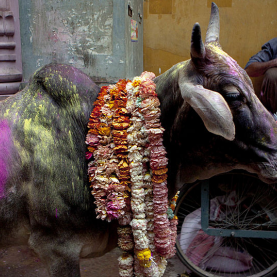Cow
Cows are female cattle and the term is also the common name for the entire ‘Bos taurus’ species. Cows are the first large mammals domesticated some 8000 years ago for their meat, milk and hide, and are also venerated as holy animals. Cows feed mainly on grass and hay, and need to have given birth to a calf to be able to produce milk.
CANOPÉ (Réseau de création et d’accompagnement pédagogiques), académie de Dijon. Dossier pédagogique réalisé par l'équipe du Jardin des Sciences, avril 2012, Exposition La vache !, 2012: http://www.cndp.fr/crdp-dijon/-La-vache-Exposition-du-Jardin-des-.html, Consulté le 18.05.2016.
SUISSMILK, La formation de la matière grasse lactique: https://www.swissmilk.ch/fileadmin/filemount/informations-speclialisees-la-formation-de-la-matiere-grasse-lactique-nutrition-fr.pdf, Consulté le 24.08.2016.
SUISSMILK, Le lait : http://www.swissmilk.ch/fr/le-lait-suisse/lait-compagnie/lait.html, Consulté le 18.05.2016.
SUISSMILK, Qu’est-ce que le lait : http://www.lemenu.ch/fr/bien-etre/lait-compagnie/lait/-dl-/fileadmin/filemount/lemenu-factsheet-produits-laitiers-lait-fr.pdf, Consulté le 18.05.2016.
FOURNIER, Alain, 2006. La vache. Edition Artémis.
MAASAI ASSOCIATION, Preserving and Celebrating Maasai Cultural Heritage: http://www.maasai-association.org/maasai.html, Consulté le 18.05.2016.
Cows across the world and through the ages
Eight thousand years ago, human beings domesticated aurochs, a species of the Bovidae family which lived in Asia, Africa and Europe but has since become extinct. In the 16th century, colonists took these domesticated bovines to America.
In the Middle Ages, bovines were most exploited for their strength and pulling power, and this is still the case in many regions of Asia and Africa. Nowadays, however, industrialised countries use these animals mainly for their meat and their milk.
Cows are not only used for their resources, but have also been venerated since Antiquity for these very same qualities. To give a few examples, the Egyptian goddess Hathor resembled a cow feeding humans and animals with her milk. In Celtic mythology, the cow is associated with Damona, the goddess of springs and in India, cows play a key role in the myth of the origin of life: The world is thought to have been born of a sea of milk from which the cow emerged, destined to feed human beings.
Cows as livestock
Cows are herbivorous mammals with cloven hoofs and two horns. They are social animals that live in herds based on a developed social hierarchy, with one dominant cow. They use postures, sounds, touch and gestures to communicate with each other as well as with humans.
In Switzerland, cattle are bred mainly on small farms, in herds of 15 to 40 cows, rather than on intensive industrial farms. They are fed on grass (between 70 and 100 kg per day), hay, salt, a lot of water (up to 180 litres a day), and concentrated supplements (2 kg per day). In these conditions, dairy cows produce an average of 28 litres of milk a day.
Grass and hay contain cellulose, which makes them difficult to digest and thus explains why cows have four stomachs. Digestion includes a particular stage, called rumination, where once food has been chewed and swallowed, it is then brought back up into the mouth to be chewed again before being swallowed again and then digested. Cows ruminate for around 8 to 12 hours a day.
By-products from cows
All of a cow’s resources can be used, even its dung, which is used as a fertiliser or as building material. However, milk, leather and meat are the most commonly used resources. While cows initially produce milk to feed their offspring, they produce an impressive 85% of the milk consumed across the world, the equivalent of almost 800 million litres a year.
Some of this milk is consumed in its natural liquid form, while some is processed into yoghurt, cream, butter and cheese.
In Kenya and Tanzania, the Maasai tribe believes bovine blood to have the power to protect the body and eliminate toxins. It is therefore consumed during ritual ceremonies and in cases of disease and inebriation.
Nutrition
Whole milk is an important source of calcium, but it also provides carbohydrates (lactose), lipids and proteins. Among the lipids contained in whole milk (more than 3.5%), saturated fatty acids should be consumed in moderation, hence semi-skimmed or skimmed milk may be recommended for those who consume large quantities of milk.







